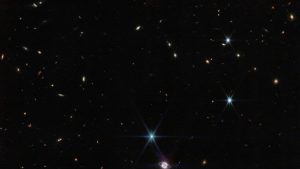El telescopio James Webb capta los impresionantes anillos de Neptuno
La imagen es la vista más clara a los anillos del planeta en más de 30 años.

El mayor observatorio astronómico jamás lanzado al espacio capturó los impresionantes anillos del planeta helado, que no se habían visto con tanta claridad desde las capturas de la sonda Voyager 2 en el año 1989.
Mire También:
Las mejores adaptaciones de las escalofriantes historias de Stephen King
Joven dejó que su novia abriera OnlyFans y ella le regaló una moto al mes
Latin Grammy 2022: lista de rockeros nominados a los premios
Neptuno fue descubierto en el año 1846 por el astrónomo alemán Johann Gottfried Galle, y está situado en una de las zonas más oscuras del sistema solar, sin embargo, el telescopio pude llegar a él y captar las impresionantes imágenes con las que más de uno ha quedado cautivado.
Hey Neptune. Did you ring? 👋
Webb’s latest image is the clearest look at Neptune’s rings in 30+ years, and our first time seeing them in infrared light. Take in Webb’s ghostly, ethereal views of the planet and its dust bands, rings and moons: https://t.co/Jd09henF1F #IAC2022 pic.twitter.com/17QNXj23ow
— NASA Webb Telescope (@NASAWebb) September 21, 2022
In visible light, Neptune appears blue due to small amounts of methane gas in its atmosphere. Webb’s NIRCam instrument instead observed Neptune at near-infrared wavelengths, so Neptune doesn’t look so blue! pic.twitter.com/aZZa8B8x4f
— NASA Webb Telescope (@NASAWebb) September 21, 2022